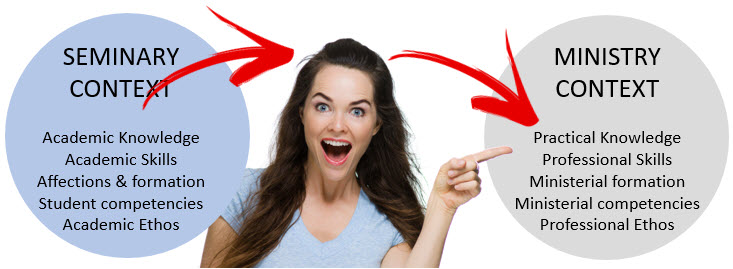
Integration? Maybe You're Focusing on the Wrong Thing
Every once in a while, integration becomes the golden fleece in curriculum design, teaching, and assessment. Deans can feel pressured to identify the way the curriculum, and the Faculty, integrates subjects and learning in the curriculum and its course of study. They may feel frustrated when called upon to find ways to demonstrate, through assessment, that integration is taking place: what it looks like, to what degree, for what outcome. This points to a fundamental challenge: in what ways and to what extent are the things learned in seminary transferable (applicable) to ministry contexts?
Novice deans often wrestle with some basic questions. What are we trying to integrate--subjects, fields
of study, concepts, skills----all of them? Who is supposed to do the integration--faculty? Students? How do we assess integration? What evidence do we look for? How do you grade it? What does it look like, anyway?! Attempts to engage the faculty in how to integrate the curriculum become frustrating and ultimately futile.
If you are frustrated trying to integrate, maybe you're focusing on the wrong thing.
Transference of learning.
A more helpful framework to focus on may be transference of learning. Transference of learning is a powerful indicator of higher order learning. It denotes the ability of a student to take something learned in one context or a particular field of study, and apply it in a different context or field of study. Transference of learning provides evidence of higher order learning: synthesis, imagination, application, innovation, and creativity.
Focusing on transference of learning keeps the focus where it belongs: the student's attainment and mastery of learning. One common attempt among faculty is to focus on integrating content learning---concepts from distinct and diverse fields of study. While that is possible, in reality, it rarely happens by intent or design, and more often than not by serendipity, if at all. Busy faculty members rarely spend enough time in conversation among themselves about their own scholarship, fields of expertise or even discuss their own teaching and courses to creatively design integration in a course of study.
Focusing on transference of learning can be a more effective framework for faculty discussion about teaching and learning and its outcomes. Ask a professor "How do you strive to integrate what you teach in your course with what students are learning in a course in a different field of study?" and you'll likely succeed in merely stumping the teacher. Ask, however, "What are those things in your course you want to see your students use or apply in other courses as they continue their courses of study?" and you'll likely get a clear and confident response---and a hint about what to look for.
While the concept of transfer of learning is easier to grasp than the vague "integration," it must nevertheless be applied with informed rigor in order to be effective as a framework for teaching and learning in the curriculum. Dale H. Schunk provides a list of types and characteristics of transfers of learning from the literature of educational research. The summary below can serve as a guide to develop program level goals, craft course learning outcomes to align with those goals, and point to evidence for assessment.
Types and Characteristics of Transfer of Learning
- Overlap of learning between situations and contexts: the original and transfer contexts are similar ("near")
- What is learned in one context enhances learning in a different setting ("positive")
- Knowledge of a previous topic is essential to acquire new knowledge ("vertical")
- Knowledge of a previous concept is not essential but helpful to learn a new concept ("horizontal")
- Explicit new knowledge transfers to new task ("literal")
- Use some aspect of general knowledge to think or learn about a novel problem ("figural")
- Transfer of learning involves abstraction requiring conscious formulations of connections between contexts ("high road")
- Abstracting situations from one learning context to a potential transfer context ("forward reaching")
- Abstracting in the transfer context features of a previous situation where new skills and knowledge were learned ("backward reaching").
Engaging the Teaching Faculty in conversation about transfer of learning can re-shape its thinking about course methodology and learning outcomes. Using transfer of learning as a framework for assessment may make evaluation of "integration" a less stressful and more effective way to measure student learning.
Starting Questions
What evidence do you have that students use what they learn in one cognate field of study as applied in another?
What evidence do you have that students are able to apply what they learn in academic courses in their ministry contexts?
What evidence do you have that students are able to apply what they learn in core courses in their field-based studies and supervised ministry experiences?
What transference of learning do you wish to see in what students are learning in basic Bible courses to homiletic courses?
What transference of learning do you wish to see between acquired academic skills and ministry context competencies?
SOURCE: Schunk, D. (2004). Learning theories: An educational perspective (4th ed.). Upper Saddle River, NJ, USA: Pearson, p. 220.

Leave a Reply